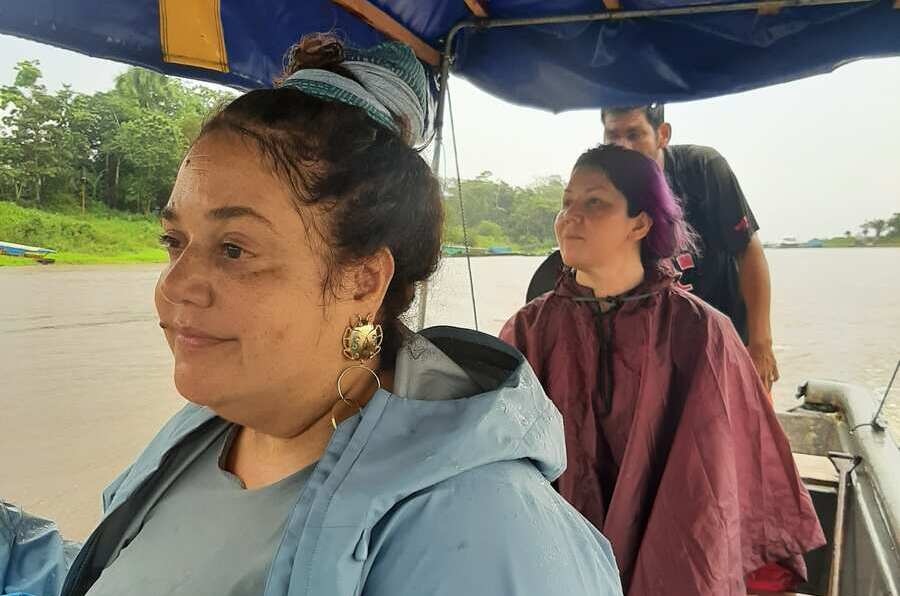Last year, I wrote an article for American Theatre titled “When Worlds Fall Apart, There’s Nuestro Planeta.” It was a profoundly personal article because I wrote it while my family and I were deciding the fate of my brother José. A COVID long-hauler, he had been hospitalized for 18 months. As his health deteriorated, the doctors asked us pointedly: Is this the life José would have wanted for himself? It became clear that the answer was no, and that José would not recover.
Disheartened by what the pandemic was doing to my company, Hero Theatre, and devastated by the helplessness I felt about my brother’s declining health and the geographic distance between us (he was in a hospital in Maryland, I was in California), I enrolled in the Social and Environment Arts Practice MFA at Prescott College. There I received mentorship from Black Lives Matter co-founder Patrisse Cullors, who was then running the program. In class, Patrisse encouraged me to continue creating theatre while helping my family and community, which is at the heart of Hero Theatre’s mission. And so, as I traversed the distance between my brother and me via Zoom hospital visits, Nuestro Planeta was born.
Nuestro Planeta is a project rooted in research on environmental justice issues in Latiné countries and how Latiné American families are directly affected. Much of the project entails taking Latiné writers back to their ancestral homelands as a form of healing through connecting to the Earth in a place where we are not seen as others. It also involves me working with local community members and scientists to determine the effects of the climate crisis on these areas and devising ways to use theatre to share information so that they protect themselves and become stewards of the Earth. The project now includes commissions for writers to visit Colombia, Guatemala, El Salvador, Puerto Rico, Haiti, Mexico, and the state of California, where Hero Theatre is located. Initially meant to last ten years, the project has become Hero Theatre’s core.
I am writing now on Nuestro Planeta’s first anniversary, shortly after our first commissioned playwright, Diana Burbano, and I reconnected in Colombia for our second research trip. I currently live in Bogotá, wrapping up the first part of my environmental justice research on a Fulbright grant. Diana lives in Southern California and has been busy with recent productions of her plays Fabulous Monsters, Sapience, and Ghosts of Bogotá. From our playwright-director collaboration emerged a true friendship that withstood a pandemic tearing through our industry, hazardous drives, painful bird pecks, falling through a bridge, and me falling in love.
It started with a Bogotá reunion. Diana stepped out of the cab after a long red-eye flight, and I went in for a big hug at the sight of her purple hair and hot pink jacket. We were so happy to see one another again. It had been a year since our first research trip to Colombia.
Later at dinner, I talked her ear off, sharing stories of my Fulbright work volunteering in Colombia’s areas deeply affected by the climate crisis. Gustavo Petro, Colombia’s recently elected president, selected Afro-Colombian Human Rights and environmental activist Francia Márquez as his running mate. Colombia is a place of hope and the deep belief that collective community work is vital to achieving environmental justice.
As part of my Fulbright experience in Colombia, I teach personal-story-through-nature writing workshops to local community members and write educational plays about the environment performed at schools in remote areas of the country. I also wrote a Spanish-language play about the endangered wetlands of Medellin for my host institution, Instituto Humboldt. I do this to care for and give back to Colombia, a country that has treated this Boricua girl so well. It is also a country that has to endure punishing conditions due to a climate crisis it’s not to blame for.
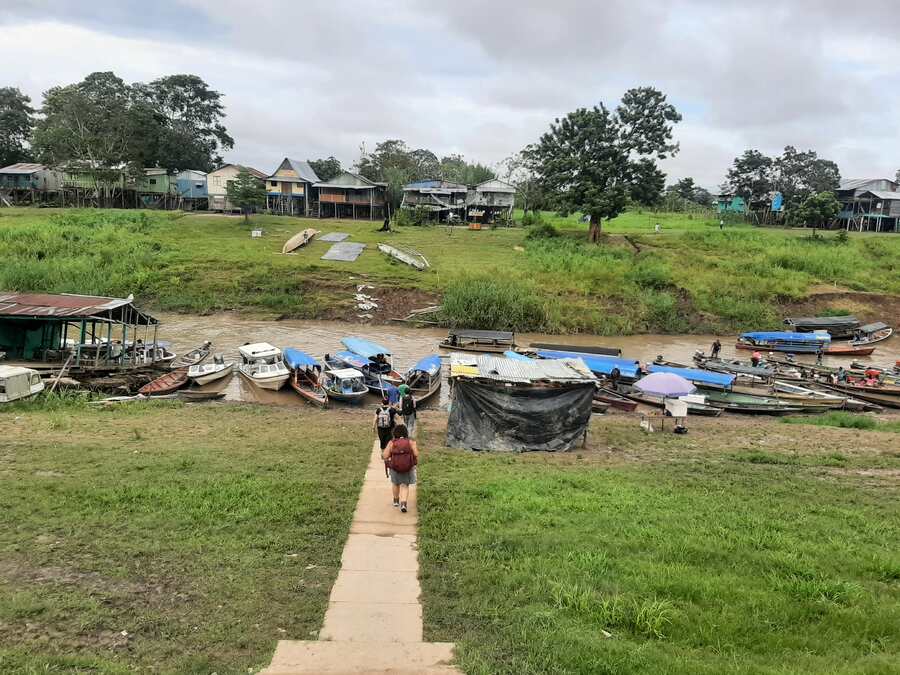
Every region of Colombia has its own accent, foods, and unique way of being. It’s a culture I have grown to love deeply and one that Diana wonders if she is still a part of. “I feel like I’m from neither here nor there,” she said.
Diana’s trips to Colombia had always been fraught with disconnection. On her last trip, she discovered that despite being born in Colombia, she didn’t particularly feel like she belonged. She felt like a cultural anthropologist. Landing in Bogotá and exploring it without the constraints of being with family made her realize that she was an exotic creature, taken out of her natural habitat and not entirely suited to be returned. Latin America was always a shock to the system because she realized she was a tourist in the place she was born.
Forty-eight hours later, we found ourselves at Bogotá’s El Dorado Airport, ready to revisit the Amazon Rainforest region of Colombia. At the airport, we met up with biologist and nature photographer Andrés Felipe Jimenez, who had flown in to meet us from Medellin, and together we all traveled to Leticia. In this Colombian port town, you enter the Amazon. Andrés—or Felipe, as he likes to be called—told us he had published a study of every plant surrounding the Leticia airport. This guy meant business.
Last summer, we workshopped the first act of Diana’s play at New York Stage and Film. Though it was well received, I encouraged Diana to hold off on writing a second act. I felt an additional research trip was needed, especially since the lead character, Alondra, leaves the coffee region and enters the rainforest on a cliffhanger, leaving NYSAF’s audience members wanting to hear more.
The last time we visited the Amazon, I befriended tour guide Neider Anderson Teteye. We shared a special connection, as he reminded me of my ailing brother José. Neider taught us about the animals of the rainforest and about the deforestation happening. He took us swimming in the Amazon twice and later admitted piranhas were in the water. Still, he told us, “The most dangerous animal in Las Amazonas is the human.” On this trip, we aimed to learn about how the various Indigenous communities there lived and explore plant life. Having lived and worked in the Amazon, Felipe was happy to serve as our plant expert, photographer, and guide.
He suggested our first stop be Leticia’s best restaurant, Tierras Amazónicas. We were exhausted and hungry. Colombia is not an easy place to travel through. As the taxi pulled up to the restaurant, Diana and I got emotional. Coincidentally, this restaurant was where we ate on the final day of our first research trip to the Amazon, covered in mosquito bites and sunburned. We took this as a sign.
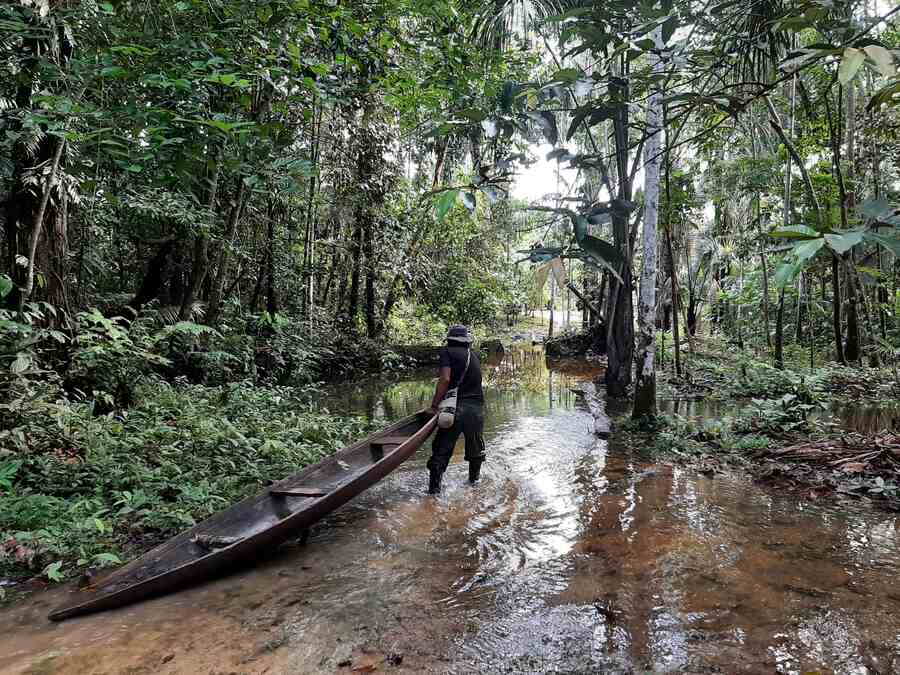
Going to Leticia, Diana felt fewer of the constraints of America vs. Colombia because Leticia, a port city that connects Peru, Brazil, and Colombia, is, like all port cities, a melting pot of peoples and languages. It takes concentration and wits to get around. It was raining. Big rain, huge rain—and much needed because, as we learned, the Amazon River was way down. The port where last year we had left on the Transfluvio to Puerto Nariño was inaccessible to bigger boats, and we had a muddy, slippery walk to our new point of transport.
The transfluvial, a long, lean water taxi, was crowded with people, as all “rapid transits” were. One thing you can’t be in the Amazon is a nervous or fussy traveler. And accessibility is negligible. You must be ready to run, climb, and Indiana Jones yourself out of quick mud and flooding rainforest.
Our first landing was Cabañas Alto del Aguila, a lovely eco-lodge a short boat ride from Puerto Nariño proper. It was previously the lodge for the priests who taught at an Indigenous school where the children were indoctrinated, baptized, and otherwise “saved.” The religious aspect made a huge impression: Many elders we spoke to peppered their language with “Gracias a Dios” and other professions of faith, especially when we were chatting with them about their various methods of natural cures, Indigenous medicines, and techniques. As their culture had been considered satanic, so much knowledge and language has been lost.
One difference we noticed was what the native people of the region called themselves. The religious ones referred to themselves as Ticuna, a name the conquistadors gave them to describe the black marking they had on their faces. Those not indoctrinated and fighting to return to their original religious practices and ceremonies told us their name was “Magüta,”i.e., “the people who triumphed.” We had interviews set up with people in the region and did magnificent rainforest walks to get to them.
Things you should know about the Amazon: Everything wants to kill you. The quick mud will suck you into its depths faster than a blink of an eye. Don’t touch trees, leaves, or branches if you’re falling because even if they are not poisonous, there will be a scorpion spider, a (poison) frog, or some other scary creature that will land on you. The wood on the bridges is rotten and will break, the rivers and streams are forded on logs barely wider than your feet, and the rain is relentless. It’s glorious.
Once we did reach the village, we had a long, beautiful conversation with Don Mauricio Laureano, who told us a little about his people’s teachings and traditions. These people were not Magüta but people displaced from other regions of the Amazon. I discovered that many Indigenous tribes living in the Puerto Narińo region were not native to the area but had gathered there. The place was not theirs; it did not contain birds or plants they knew, let alone their original way of life. And Christianity erased most of their traditional healing and rituals.
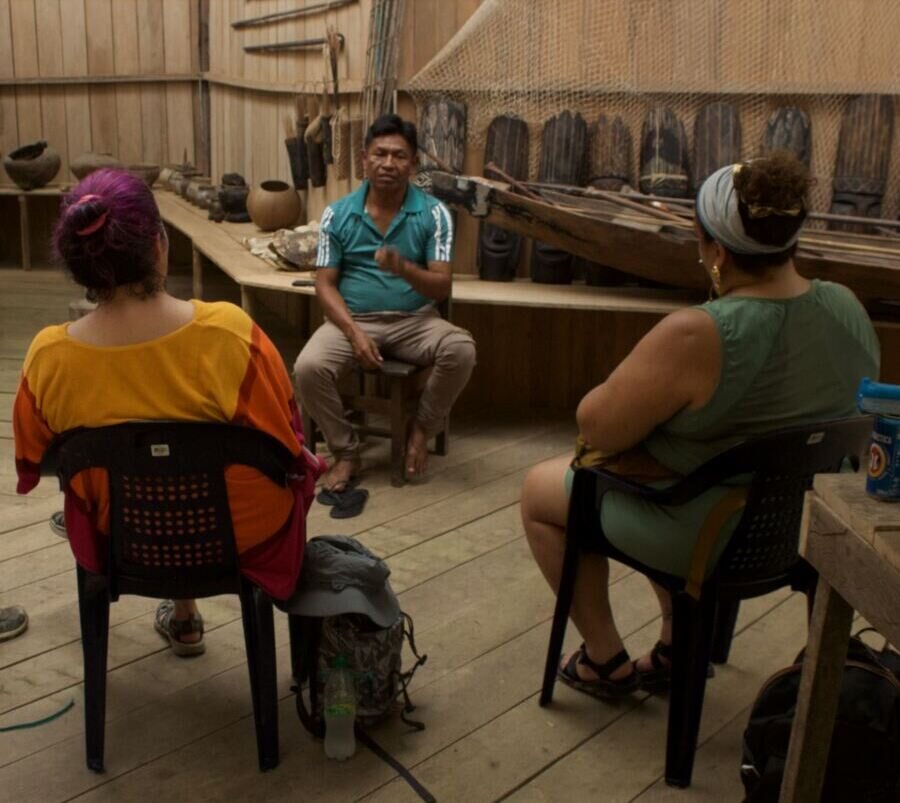
The following day we woke up early and began a hike from our lodging in Puerto Nariño to visit the community of San Martín de Amacayacu, where the Ticuna people live. Felipe told us that walking at an average pace, the hike would take about four hours. We began the trek slowly, taking in the plant lessons Felipe gave us along the way. He is also a bird expert, and we were blown away by the amount of knowledge he had about the flora and fauna of the Amazon.
We heard the sound of thunder coming, and Felipe urged us to walk faster. He looked scared and warned that the mud would be so thick we wouldn’t get through if it rained. But the rain began to pour. We trekked as fast as we could. I remember stumbling upon a young Indigenous hunter with a large rifle. Felipe said that he just needed to pass us as he was probably on his way to hunt for food to feed his family.
Further along, we had to cross two water canals by stepping slowly on a log as if walking a tightrope. After we crossed the first log, I stepped into what felt like quicksand. My entire leg sank into the mud. Diana watched in fear as Felipe pulled me out slowly.
Upon approaching the second water canal log-tightrope crossing, I fell again. This time, both of my legs stuck deep into the mud. Diana screamed to Felipe, “I’m going to keep going to make way.” I said to Felipe, “Please don’t let her go alone. You don’t understand Diana. She will go far to find help.” Felipe assured me she wouldn’t; he trusted her to stay safely close. What he didn’t understand was that Diana and I had become sisters. We were protective of one another. Our collaboration had already involved us taking a research trip to the Amazon, and a drive up to Parque Tatamá in Colombia, one of the only virgin moorlands in the world, that involved a drive up a steep mountain with no guardrails.
I fell again at Felipe’s first slow attempt to pull me out of the ditch. This time, he dropped with me, and I burst into tears. I was so embarrassed.
Seven hours later, completely covered in mud, Felipe and I arrived in the community of San Martín de Amacayacu. I was parched. Upon approaching a small home that sold refreshments, I caught sight of Diana’s purple hair. She was there arranging for help to come find us.
I downed two sugary apple-flavored gaseosas, and we rushed to meet Victor Pereira, a shaman-like person who is a keeper of knowledge of the culture of the Ticuna people. Victor is an interpreter of nature and makes cures and incense from copal tree bark and other natural elements. Victor is also well known for conducting ayahuasca ceremonies in the jungle, which are popular with tourists. Victor sang for us at his home and shared incredible stories about what nature means to his community. As we said goodbye to Victor, he offered me ayahuasca. I politely passed. That hike was enough of a spectacular experience for me.
The following day, in the village of Mocagua, we met with Professor Abel Santos, a scholar, linguist, and historian. He has gathered items and histories sacred to the Magüta and gathered them in his museum. He is the keeper of the stories and is fiercely protective of his culture. The tragedy is that his people, while still connected to their lands, are moving inexorably into the world of smartphones and streaming and are less interested in learning the language and stories.
We had lunch at a women’s collective on the island, a rare opportunity to speak to the women. They told a story of practicality: Ecotourism may be the thing that will strike a balance between keeping their world as intact as possible and feeding and clothing the people of the region.
I don’t believe North Americans really understand the poverty that the Indigenous peoples of the Amazons endure. Forced into Christian society, indoctrinated but not given tools to survive in situ, many Magüta, Uitoto, and other Amazonians leave because there is no work for them in the region.
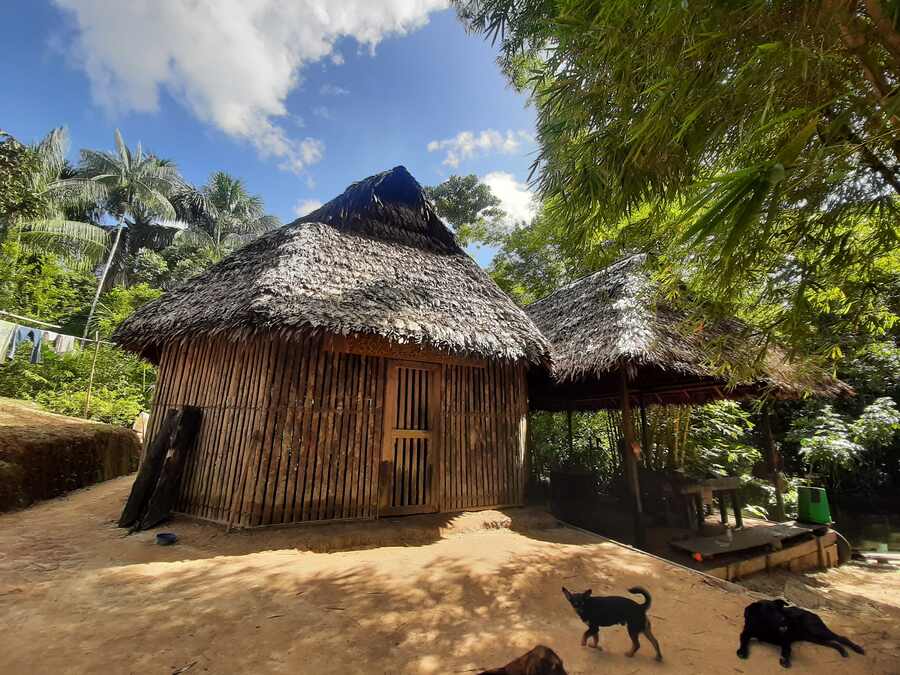
We returned to Leticia and met with elders and teachers in the Kilometro 11 community. These are the displaced Indigenous Huitoto people. Comunidad Casilla Naira, a stop along the Tacana River, is a small village where the people farm with methods that appear destructive but are thousands of years old, passed along through generations, and work in concert with the rainforest. They clear-cut land to farm and make what they call chagras in the middle of the forest, growing yuca, which is where cassava, a root staple of their diet, comes from. They also grow plantains, pineapple, lulo fruit, and ají. The land is farmed until it grows fallow, then is left to regrow while another patch is deforested. This allows the jungle to grow back and doesn’t decimate the plants and animals; the chagras are not very big.
The people here live from farming, fishing, and tourists. They also make, sell, and consume mambe and tobacco. Mambe is coca leaves ground to a powder, then stuck in their mouths as a wad. The tobacco is smoked, chewed, and also combined with the mambe and snorted.
Indeed, it’s almost impossible to stay in recovery in the Amazon. Just as you graciously eat what’s put in front of you, as your hosts have often gone out of their way to feed you with what little they have, when you’re offered booze or mambe in every social situation, it is rude to say no. Mambe is pervasive; almost every man of age in this region has the telltale green ring of coca powder around their mouth. A former party girl, Diana finds staying sober harder than any hike or physical exertion—and there is no AA in the rainforest! When she’s coughing, she is offered a shot of aguardiente and gets a huge laugh when she says she doesn’t drink.
The last big hike to the Comunidad Muinane of the Huitototo people started inauspiciously beside the landfill, where giant vultures circled. Our guide Gori Negedeka is a birder, and he’s teaching his son to identify birds by their sounds. As we walk, we pause to name the species. It’s a beautiful, soothing walk, the paths are less treacherous and drier, but we’re still fording water caused by the river rise. The people at this chagra are farming but also working on ecotourism. Sustainable ecotourism is a way to ensure that the rainforest survives and brings much-needed money to the people of the region. Indigenous guides are the best way to make the rainforest accessible to tourists. And birding is a huge attraction. Gori had books and books of birds and could sing like many of them to bring the birds closer. There is a sadness that this region is not his people’s ancestral region, and the birds are not “his birds.”
The Huitoto were devastated by COVID. The village alone lost hundreds, including the elders, speakers of the native language, and story keepers. Our guide lost his parents, grandmother, and, like me, his brother because of the pandemic. It is not lost on me that, yet again, diseases brought in from outside have ravaged the native peoples of the region.
We returned to Leticia exhausted the following day and then back on a plane to Bogotá. Trips to the Amazon change you. You see a lot that makes you face your privilege and realize what is missing from your life.
It is the first anniversary of my brother’s passing. But as I lost one loved one, I gained another. Felipe, our guide and plant expert who pulled me tearfully out of the mud, and I fell in love during this trip. Next February, we will be married.
My research year confirms that my life now belongs to Nuestro Planeta. I am grateful to Diana, for through this commission, she gave me the gift of Colombia. She took careful notes, even throughout the most challenging part of our travels, and has incorporated them beautifully into her play, bringing so many memories back as I read the pages. I also thank the Fulbright Commission, Instituto Humboldt, and the beautiful people of Colombia.
Hero Theatre just found out we won an NEA grant to help support the production of Diana’s play. We have a way to go, though. I hope to raise enough money, as I’d like to use technology to bring what we saw in the Amazon rainforest to life for our audiences.
Most of all, I hope that through this work, they, too, become inspired to become part of the fight to save nuestro planeta.
Elisa Bocanegra (she/her) is an actor and the artistic director of Hero Theatre, which she founded with the help of her mentor Olympia Dukakis. Diana Burbano (she/her) is a playwright whose plays include Ghosts of Bogotá, Sapience, and Fabulous Monsters.

